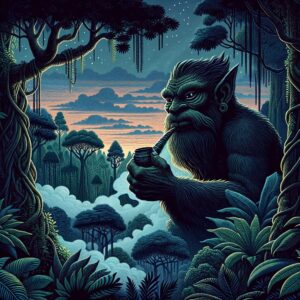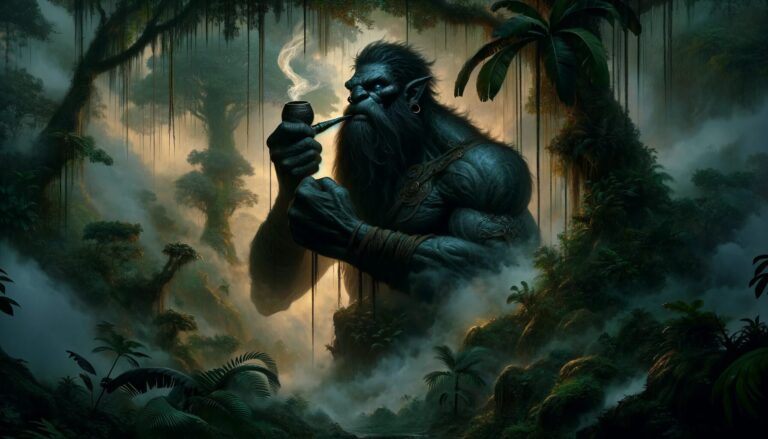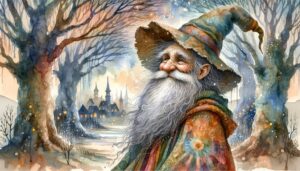Table of Contents
In the rich tapestry of, the Kapre stands as a towering and mysterious figure. A creature of great intrigue and captivating mystique, the Kapre’s presence looms large, both literally and figuratively, within the annals of Filipino mythology. This mythical being, often described as a giant with an insatiable fondness for tobacco and a penchant for causing mischief, has been a subject of fascination for generations. In this comprehensive exploration, we shall delve deep into the enigmatic world of the Kapre, uncovering its origins, family ties, appearance, abilities, symbols representing it, and the myriad of myths and stories that have sprung up around this remarkable figure.
Origins and Family Ties

The cultural history of the Philippines deeply intertwines the origins of the Kapre. Its name derives from “qafir,” an Arabic word, hinting at contact between Muslim traders and indigenous Filipinos. Over time, “Kapre” became synonymous with this creature, reflecting the interplay of cultural exchange and indigenous mythology.
In Philippine mythical creatures, the Kapre links with diwata, fairy-like beings. Unlike benevolent diwata, the Kapre stands solitary and malevolent.
While solitary, the Kapre shares a familial connection with forest-dwellers like the tikbalang (half-human, half-horse) and nuno sa punso (dwarf-like anthill residents). These subtle links imply a complex ecosystem of mythical beings in Filipino forests, each with distinct roles.
Appearance

The Kapre’s imposing appearance stands out. It towers at heights exceeding ten feet, covered in matted, mossy hair that creates a shaggy, wild look, seamlessly merging with the forest’s dense foliage. With a complexion resembling dark bark, it can blend into trees, making it nearly invisible to unsuspecting passersby.
Fiery red eyes are a common depiction, emitting an eerie, malevolent light. Hidden within its tangled hair, these eyes are believed to possess a hypnotic power, drawing those who gaze upon them into its mystical realm.
Abilities
The Kapre possesses unique abilities matching its appearance. Among its well-known traits is a fondness for tobacco. This giant delights in smoking cigars or pipes, often accompanied by the sweet scent of tobacco smoke. Some believe offering a lit cigar or tobacco can appease it, ensuring safe passage through its forest domain.
However, the Kapre’s tobacco fascination goes beyond mere enjoyment. It wields control over smoke, creating illusions that disorient travelers in the forest. This power adds treacherous enchantment to its character, leading people astray and leaving them lost in the labyrinthine woods.
Shapeshifting is another of the Kapre’s abilities, enabling it to assume various forms, confusing or terrifying its victims. It can mimic forest animal calls or even impersonate a loved one, luring prey deeper into the wilderness.
Despite its penchant for mischief and its eerie abilities, the Kapre is not inherently evil. Some stories depict it as a guardian of the forest, ensuring that those who enter its domain respect nature and tread lightly. In these narratives, the Kapre serves as a reminder of the importance of preserving the natural world.
Symbols

The Kapre is a multifaceted figure with various symbolic interpretations. One of its most prominent symbols is the towering tree, representing the Kapre’s affinity for forests and its ability to blend seamlessly into the natural world. The towering figure of the Kapre mirrors the grandeur and mystery of ancient trees that dominate the Philippine landscape.
Tobacco, in its various forms, is another potent symbol associated with the Kapre. It serves as a tangible offering to placate this mythical being, emphasizing the importance of appeasement and respect when venturing into the wilderness.
The Kapre’s fiery red eyes, often described as hypnotic, symbolize the allure of the unknown and the seductive pull of the forest. They serve as a warning to those who dare to wander too deeply into the woods without due caution.
Myths and Stories
Throughout the Philippines, countless myths and stories have been woven around the Kapre. These tales provide insight into the complex and often contradictory nature of this mythical being.
One common theme in Kapre stories is its penchant for abducting or seducing young women. In these narratives, the Kapre is portrayed as a lascivious and predatory figure, luring unsuspecting maidens into the forest with its enchanting presence. Such stories serve as cautionary tales, warning young women to be wary of the dangers that lurk in the wilderness.
In contrast, other stories depict the Kapre as a guardian spirit of the forest. It is said to protect the flora and fauna from harm and guide lost travelers to safety. In these tales, the Kapre embodies the symbiotic relationship between humans and nature, highlighting the importance of respecting and preserving the environment.
The Kapre stars in stories where it mischievously engages with humans. It delights in playing pranks on unsuspecting individuals, like rearranging their belongings or leading them on forest wild goose chases. These narratives highlight the Kapre’s trickster nature and stress the necessity of humility and respect while venturing through its territory.
Cultural Impact

The Kapre’s enduring presence in Philippine folklore has left a significant mark on the culture and psyche of the Filipino people. Its portrayal as a guardian of the forest underscores the deep connection between Filipinos and their natural surroundings. It serves as a reminder of the importance of environmental conservation and the need to coexist harmoniously with the wilderness.
In literature and art, the Kapre often appears as a symbol of the unknown and the supernatural. It adds an element of intrigue and mystery to stories and paintings, captivating the imagination of both creators and audiences alike.
In contemporary times, the Kapre continues to be a popular subject in Philippine popular culture. It frequently appears in movies, television shows, and books, offering a bridge between tradition and modernity. The Kapre’s enduring popularity attests to its enduring appeal and its ability to resonate with people of all ages.
Thematic Exploration
The legend of the Kapre offers a thematic exploration of several key concepts and ideas.
Firstly, it serves as a metaphor for the uncharted and mysterious aspects of life. Just as the Kapre can lead travelers astray in the forest, life itself can often be filled with unexpected twists and turns. The Kapre reminds us to approach the unknown with caution and respect.
Secondly, the Kapre embodies the duality of nature – both nurturing and destructive. It can be a protector of the forest’s beauty and a guardian of its secrets, but it can also be a source of danger and chaos. This duality reflects the delicate balance that exists in the natural world and the need for humans to coexist harmoniously with it.
Lastly, the Kapre represents the idea that appearances can be deceiving. Its shaggy, imposing exterior hides a complex and multifaceted character. This theme of hidden depths and the importance of not judging based on outward appearances is a universal and timeless message.
In conclusion, the Kapre stands as a captivating and multifaceted figure within Philippine folklore. With its origins deeply rooted in cultural exchange and indigenous myth, its imposing appearance, intriguing abilities, and symbolic representations have made it a central figure in the rich tapestry of Filipino mythology. Its diverse portrayal in myths and stories reflects the complexity of human nature and our relationship with the natural world. As a guardian of the forest and a symbol of the unknown, the Kapre continues to captivate the imagination of Filipinos and people around the world, reminding us of the enduring power of myth and storytelling to connect us to our past and inspire our future.
FAQ
What does a Kapre look like?
Towering, shaggy, with fiery red eyes.
What are its abilities?
Shapeshifting, tobacco affinity, illusions.
Is the Kapre good or evil?
It varies in myths, sometimes mischievous, sometimes protective.
What does the Kapre symbolize?
The forest, mysteries, hidden depths.
How has the Kapre influenced culture?
Popular in art, literature, and modern media.





